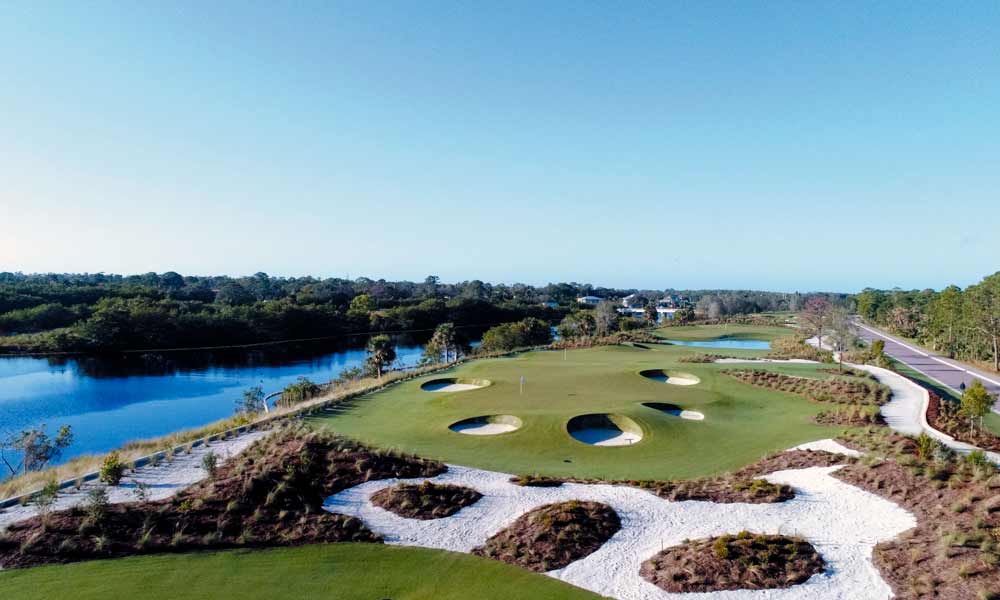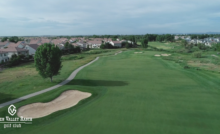The Team that’s Bringing Donald Ross’ Vision Back to the Biltmore Miami


To understand the full picture of the restoration and refurbishments, you’ll want to read, “The Biltmore Golf Course Miami Returns to Its Roots.”
The season may be winding down at many golf facilities across the US, but in sunny Coral Gables, Florida, the Miami Biltmore Golf Course is gearing up for its busiest time of the year. Snowbirds, (those who live in northern climates and winter in the south) who have not played the course since last spring, will no doubt be surprised at the subtle but significant changes the Biltmore has undergone over the summer.
In a project led by golf course architect Brian Silva and executed by Chris Kleinsmith and Duininck Golf, the management at the Biltmore sought to restore the course by bringing back important elements of its 1925 Donald Ross design. In many cases, these “lost Donald Ross design elements” had not been intentionally changed; they had simply slipped away over time, transformed both by weather and by the countless rounds of golf played over the years on the Biltmore’s eighteen holes.
Bob Coman, PGA, Director of Golf Operations at the Biltmore, provided us with a hole-by-hole look at the renovations. In reflecting on the work done on the course, Bob observed, “I think Donald Ross would be pleased by what was done by Brian Silva and Duininck Golf to restore his original golf course design and playing characteristics. The golf course and practice facilities are now as good as any to be found anywhere.”
Overview of the Restoration at the Miami Biltmore Golf Course
- On the Hole 1 green complex, the green surround was sodded, and the green was sprigged with Tif-Eagle. The bunker behind the green has been restored and a right greenside bunker removed to bring back the original Donald Ross design.
- Hole 3 green was sprigged on August 16. Significant germination and establishment occurred in less than two weeks. Four Australian Pines and one large ficus tree were removed from the northeast side of the green, enabling visibility of the Biltmore tower from additional vantage points.
- A corridor connecting the fairways on Hole 1 and Hole 5 was restored by removing trees and a bunker. The left-corner fairway bunker on Hole 5 was also restored.
- The original Donald Ross-designed fairway bunkers on the right corner of the Hole 5 dogleg were restored.
- The practice putting green was expanded from 5,000 square feet to 10,000 square feet and sprigged on August 31, 2018.
- The short game practice area was increased from one green and one bunker to three greens, two bunkers and a grass bunker. Each 4,000-square-foot target green received greens mix and was sprigged.
- Hole 12 was restored to the original 249-yard Par 3 design with no greenside bunkers.
- The Hole 14 green complex was restored to the original 1925 Donald Ross “thumbprint” green design.
- Tees were stripped, and the old greens mix was repurposed for use as the tee mix. The tees were then laser leveled and sprigged with 419 Bermuda.
- The original Donald Ross bunkers were restored on the left side of and behind the seventh green. A greenside bunker on right side of the seventh green was removed to allow for run off to the Coral Gables Canal, as originally designed by Ross.
- Of the holes restored on the course, Hole 18 has become one of the most memorable. The severely undulating green was expanded from 5,000 square feet to 10,000 square feet. The expansion brings the steep fall-off on the left side of the green into play.
- Bunkering around the entire left side of Hole 18 green was restored.
Duininck Golf is Focused on Every Budget, Every Timeline and Every Situation
In addition to the contributions made by Brian Silva and Bob Coman, much of the credit for the successful restoration at the Biltmore goes to the hardworking team at Duininck Golf. Duininck is an organization with a rich heritage and a solid future that started in the construction business and has expanded into the golf industry.
Founded in Prinsburg, Minnesota, in 1926, by Henry, Amos and Wilbur Duininck, the company originally focused on the heavy civil construction business. Clearly the three Duininck brothers were thoughtful and forward-thinking businessmen. Even though they launched their business just as the American economy was slipping into the Great Depression of the 1930s, their road and highway construction company continued to grow. Over the years, the organization has branched out from its small-town Minnesota roots, becoming the diverse Duininck Companies that today include multiple industries and global locations.
In the 1980s, the Duininck Companies started Duininck Golf, despite the fact, that as Judd Duininck, Duininck Golf and GCBAA President Elect, explained, “No one in the Duininck family has the opportunity to enjoy the courses we serve nearly as much as we would like to; we are all too busy working. It’s a sunup to sundown job.”
Yet long days and hard work do not interfere with the deep bonds and strong comradery of the Duininck family. In a corporate structure that is atypical in contemporary business, Duininck Inc. is run collaboratively by thirteen partners, five of whom are second-generation descendants of the company’s three original founders and eight of whom, including Judd, are third generation descendants.
“We at Duininck Golf take great pride on renovating and restoring classic golf courses. Biltmore, being a Donald Ross original, has been an exciting project and has turned out great!” – Judd Duininck, Duininck Golf – GCBAA President Elect
“Everyone asks,” said Judd, “how do you guys all get along? How do you work together harmoniously? I tell them we get along because Duininck Golf is rooted deeply in our corporate values of servant leadership, stewardship, generosity, family and integrity.”
Devoted to and united by their Christian faith, the leadership at Duininck Golf strives both to operate and grow the family’s business as well as to live their personal lives by the same five values they use to guide their company.
“We live our values every day,” said Judd. “We incorporate them in our lives and in our work, and we pride ourselves on the quality of service we deliver. We demonstrate our commitment. The quality of our work and our dedication to quality project management is something we take great pride in.”
Over the years, Duininck has grown, expanding with the addition of their Southern Region Office in Roanoke, Texas. Along the way, they’ve been entrusted with renovation, irrigation or drainage projects at some of the world’s most legendary golf courses. Their portfolio of work includes Hazeltine National Golf Club where they did a bunker and other renovations before the 2016 Ryder Cup, along with projects at the Harmon Par-3 Course at the prestigious Floridan National, the Rees Jones designed Bayou Oaks at City Park in New Orleans and restoration work at Interlachen, a project that in many ways, parallels the work just completed at the Miami Biltmore.
Brian Silva, the architect on both the Biltmore and the Interlachen renovations, commented on the two projects. “There are interesting similarities between the Biltmore and Interlachen renovations, with both courses having Donald Ross layouts,” said Brian. “Bunkers were restored at Interlachen prior to the 2008 US Women’s Open and the Biltmore underwent a restoration of greens and bunkers in 2007.
“Many of the Biltmore’s existing fairway bunkers had been allowed to grow over with Bermuda grass and their restoration in 2007 largely involved replacing grass floors with sand. Additional restoration work has taken place over the past decade at Interlachen while a recently discovered original Ross plan guided the work at The Biltmore.”
As each of these two great golf courses have been guided on a path, returning to the roots of their original design, the courses have done more than honor the vision of Donald Ross or bring together Duininck Golf and architect Brian Silva as a proven team to envision and execute the work successfully. By enhancing playability and the golfers ‘on-course experience, the Biltmore and Interlachen have positioned themselves as courses that are optimistically looking ahead, confident in a golf industry that once again is trending upward, shining brighter and becoming stronger than it has been in many years.
Linda Parker has been writing professionally since the 1980s. With clients in finance, sports, technology, change enablement, resorts and nonprofit global initiatives, Linda helps organizations communicate their stories in meaningful ways to the people they most want to reach. She has authored, ghostwritten or contributed to more than a dozen nonfiction books. Linda is a member of the Authors Guild and the Golf Writers Association of America. You can connect with her at Linda@GlindaCreative.com
Recent Posts
The Rare Condor: What It Means for Golf and the Course Maintenance Behind It
Imagine this: you're on a par-5, having just hit your second shot toward the green.…
DENIOS Under Bench Cabinet Provides Safe Storage of Lithium-Ion Batteries
DENIOS introduces asecos under bench cabinets for the safe storage of undamaged lithium-ion batteries. They…
True Blue Golf Club, One of America’s Top 100 Resort Courses, Acquires Steve Dresser Golf Academy
True Blue Golf Club has acquired the Steve Dresser Golf Academy, a renowned instructional facility…
Memphis Country Club: A Golfer’s Study in Precision and Tradition
If you have ever teed it up at Memphis Country Club, you know this isn’t…
Superintendents Online Turf Directory – EVERYTHING TURF
Our online directory, directory.GolfCourseTrades.com is the go-to resource for the busy superintendent. It is your opportunity…
Foley Company attains GCSAA Silver Partner Status
Foley Company, a leader in turf equipment innovation and technology, affirms its support of the…


